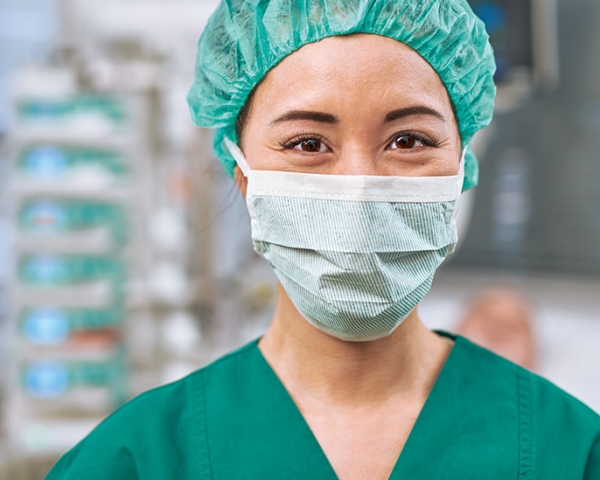Health care professional, take care of your skin
The effectiveness of using personal protective equipment (PPE), such as face masks, goggles and gloves, especially in times of COVID-19 is well known and uncontroversial.
But how can you avoid skin lesions, pressure ulcers or friction injuries, that may be painful as well as a dangerous entryway for bacterial infections, too.(1)
We have gathered useful recommendations for you:
How to prevent lesions caused by PPE - Face and behind ears
Before beginning your shift
Step 1 - Wash and dry your skin
Wash your hands, face and behind your ears with soap and water, rinse and dry carefully.
Step 2 - Hydrate or moisture your skin
Hydrate your skin with hyperoxygenated fatty acids to reduce its fragility and improve overall resistance:
- Spray a small quantity of hyperoxygenated fatty acids (HOFA), on your fingertips and apply with gentle circular movements to your skin, especially to areas exposed to pressure or friction.
Or moisturize your skin with a lotion for dry and irritated skin:
- Spread a lotion thinly onto your clean and dry skin whenever it needs moisturizing and protection.
Step 3 - Protect with a moisture barrier
Spread a barrier cream, thinly onto the clean and dry skin using fingers or apply a barrier film, using enclosed applicators.
Step 4 - Prepare and apply dressings
Customize the dressing:
- Cut the silicone foam dressing, according to the template herunder.
- Important: Leave the protective layer which shields the silicone on while cutting.
- Depending on size of your dressing, you may distribute templates differently.
Apply the silicone dressings:
- Remove one of the backing liners and apply the sticky side to the face area.
- Smooth the dressing and remove the remaining backing liner.
Important: Let any moisturizing product get absorbed before applying the dressing.
After your shift
Wash and dry your skin
Wash your hands, face and behind your ears with soap and water, rinse and dry carefully
Hydrate or moisture your skin
Hydrate your skin with hyperoxygenated fatty acids to reduce its fragility and improve overall resistance:
- Spray a small quantity of hyperoxygenated fatty acids (HOFA) on your fingertips and apply with gentle circular movements to your skin, especially to areas exposed to pressure or friction.
How to prevent lesions caused by PPE - Hands
Look after your hands
Hand lesions can be avoided simply by changing hygiene practices:
- Avoid washing hands immediately before or after using an alcohol-based product. It is unnecessary and may lead to dermatitis.(2)
- Hands should be completely dry before putting on protective gloves as skin irritations may increase if the hands are still wet from either washing or applying hand disinfection.(2)
- Optimize the hydration and nutrition of your hands on a regularly basis to maintain good skin integrity.
Moisturize your hands with a lotion for dry and irritated skin
Spread a lotion thinly onto your clean and dry skin whenever it needs moisturizing and protection.
Patients' skin at risk
Protecting fragile skin - an important part of the wound care protocol
Vulnerable skin may occur as a result of increasing age, skin disease, congenital disorders and environmental damage. Elderly skin is thinner and less resilient, more easily damaged and slower to heal than that of a younger person. It is often dry, with decreased peripheral circulation, with a lower production of fatty acids and amino acids.
Elderly people, especially those with limited mobility or those who are bed or chair based, may have specific skin care needs. Skin complaints such as incontinence dermatitis and pressure sores can be distressing, both for the sufferer but also the relatives that are involved with their care and wellbeing.
Skin protective products aim to prevent skin breakdown and help maintain healthy skin.
Clinical conditions with increased risk of skin damage:
- Venous leg ulcers: They are often the result of a vulnerable skin periwound that is thin and easily damaged by adhesives. Raised intra-capillary pressure, resulting from damage to the venous system leads to oedema, which may cause maceration
- Pressure ulcers: Sacral ulcers are particularly at risk of maceration due to the presence of urinary and/or faecal incontinence, or the presence of skin folds in obese patients.
- Diabetic foot ulcers: The predominantly neuropathic nature of plantar ulcers leads to a real risk of maceration, despite the low exudate.
Inappropriate dressing selection may also cause skin maceration.
B. Braun offers a range of products for preventing pressure ulcers and skin breakdowns for patients at home or in hospitals.
Sources:
1) Alves, P; Moura, A.; Vaz, A.; Ferreira, A.; Malcato, E.; Mota, F.; Afonso, G.; Ramos, P.; Dias, V.; Homem-Silva, P. PREPI | COVID19. PRevenção de lesões cutáneas causadas pelos Equipamentos de Proteção Individual (Máscaras faciais, respiradores, viseiras e óculos de proteção). Journal of Tissue Healing and Regeneration 2020.Suplemento da edição Outubro/Março XV.
2) WHO Guidelines on Hand Hygiene in Health Care: First Global Patient Safety Challenge Clean Care Is Safer Care. Geneva: World Health Organization; 2009. 14, Skin reactions related to hand hygiene. Available from: https://www.ncbi.nlm.nih.gov/books/NBK144008/











